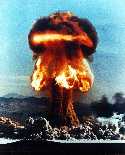 |
 |
 |
 |
 |
 |
 |
 |
 |
 |
 |
 |
 |
 |
 |
ATOMIC BOMB SIMULATION |
BACKGROUNDIn late 1939, President Franklin Roosevelt received a letter from a group of scientists warning him of the danger then developing in Nazi Germany. These men, some of whom had recently fled from Europe, feared that the Germans might be constructing an atomic bomb. This was possible, because Germany had led the world in nuclear physics since the turn of the century. If the scientists were correct, and the Nazi effort proved successful, Hitler alone would possess this new and terrible weapon. The future of Europe, and possibly the world, would be in jeopardy. The scientists' letter stated that the United States should start its own atomic bomb project. After considering this information for almost two years, FDR authorized research on the bomb in 1941. The Manhattan Project, as it was coded, began atomic bomb development in 1942.The United States entered World War II following the December 7, 1941 attack at Pearl Harbor in Hawaii. Three and a half years of conflict followed in both Europe and the Pacific. In the war against the Japanese, the Allies adopted an island-hopping technique, which though successful, was excessively costly. The last two of these engagements were particularly bloody. Iwo Jima, in February-March 1945 took the lives of 22,000 Japanese and 6,000 Americans. The conquest of Okinawa, April-June 1945, was even worse. The death total was 110,000 Japanese and 13,000 Americans, with many more wounded. Also, 368 American ships were hit with kamikaze attacks (suicide missions). One of every seven Navy casualties of the entire war was suffered at Okinawa. As the next step in the overall strategy for victory, the Joint Chiefs of Staff expected to recommend the invasion of the Japanese home islands with an American army of two million men. This final invasion, code-named Operation Olympic, together with fighting on each island was expected to cost an additional one million American casualties over a span of several years. Soldiers in the Pacific were so pessimistic in 1945 about a prolonged war that they referred to a peacetime return to San Francisco as "the Golden Gate '48" -- not expecting to have peace until 1948. The death of President Roosevelt in April 1945 brought Harry Truman to the Presidency. He learned of the Manhattan Project after being sworn into office. To deal with the important issues of the bomb's use, he authorized the creation of the Interim Committee, a small group of individuals chaired by the Secretary of War, Henry L. Stimson. This committee was asked to recommend a course of action concerning the military use of the atomic bomb. As Germany collapsed in April and May 1945, a team of American scientists followed the advancing Allied troops. They examined the remains of the German nuclear effort and discovered a failure. Crucial mistakes had been made and the Nazis were never close to the development of a reliable weapon. The United States, on the other hand, had been much more successful in its attempts to construct the weapon. After almost four years of research and development, the bomb was ready for testing in the New Mexico desert on July 26, 1945. The results proved the bomb to be even more devastating than the scientists had anticipated. The atomic bomb was now a reality. The question that remained is the one you are now to consider:
OBJECTIVESYou are to assume that it is the early summer of 1945 and that you are an important official highly placed within the wartime federal government of the United States. You have top security clearance.Germany has been defeated and the Allies are concentrating on the conquest of Japan. At President Truman's request, a specially created Interim Committee has invited you to testify about the desirability and practicality of using the atomic bomb against Japan. Your team will role play the arguments of ONE of the following four groups, each in an influential position to shape the President's decision:
FORMATEach group will have FIVE MINUTES to testify before the Interim Committee. Each group member MUST make part of the presentation to the Interim Committee. The Committee may cross-examine (question) the information that you testify about. These questions may be answered by your group as a whole, or by any member of your group. During each groups' presentation (admirals, generals, diplomats, scientists) no other group will be allowed to interrupt.After each group has made their presentation to the Interim Committee, the Interim Committee will allow the different groups to debate each other. The other three groups may ask your group questions, and your group may question any of the three other groups. The Interim Committee will vote on what to recommend to the President, and will give their reasons. They will also vote on which group had the best arguments and which group made the best presentation. |